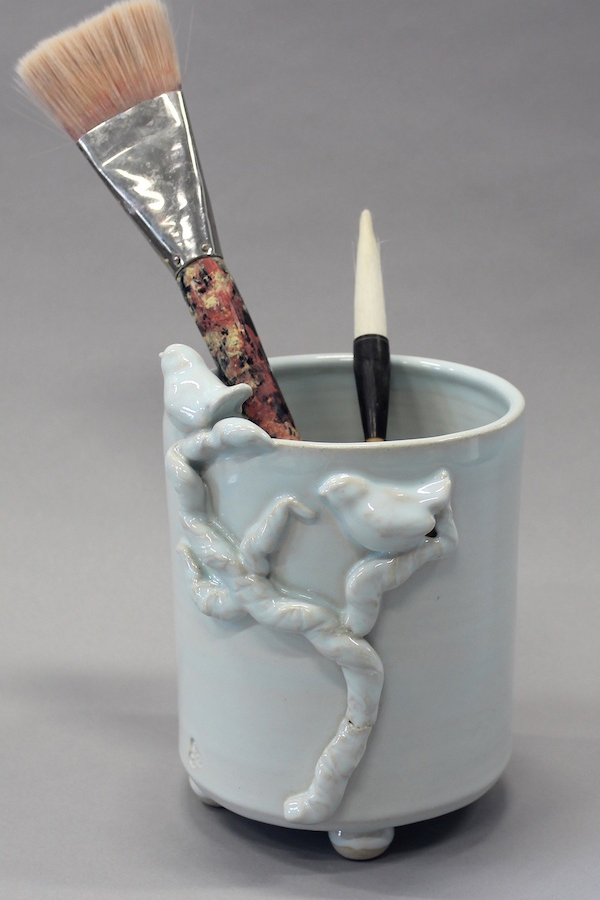Peggy Quinn
Peggy Quinn Clay Studio
East Springfield, Pennsylvania
Website
www.peggyquinnclaystudio.com
Artist Statement
I create functional and decorative pottery from my studio in East Springfield, Pennsylvania. My work is primarily wheel thrown, often with hand modeled additions. Much of my pottery is heavily influenced by simple, sedate, and elegant pottery from the Song Dynasty in China. Yet, I have an exuberant side as well. Some of my pieces can be be bright and playful, fun and funky. My work is consistently well crafted and of exceptional quality. All my glazes, slips, and underglazes are formulated in-house, using the potters' raw materials instead of purchasing commercially made finishes. I learned my craft at Edinboro University with a BFA in Ceramics and furthered my study with graduate work in Asian Art History. I have held many jobs in the ceramic field, including production potter for two companies and Clay and Glaze Specialist for a Ceramic Manufacturing plant. I also worked at the Chinese Culture Foundation in SanFrancisco in the Asian Art Gallery.
Studio Description
My studio is in an outbuilding in my backyard in rural Northwestern Pennsylvania. Many of my pieces are inspired by the beautiful nature right outside my back door. We have three large ponds surrounding our house with forest and fauna aplenty!
What type of clay do you use?
I primarily use a mid-range firing white stoneware-like clay, Laguna Bmix with and without grog. I recently tried a mid-range dark buff stoneware from Standard Clay.
What temperature do you fire to?
Cone 6
What is your primary forming method?
Wheel-thrown and handbuilt slab
What is your favorite surface treatment?
I do carving both with sgrafitto and without slip– and hand–painted motifs under and over glazes.
Do you make any of your own tools?
Not much, mostly just sharpen existing tools.
What one word would you use to describe your work?
Unique
What is your favorite thing about your studio?
It is just outside my back door so I can work on things when they are the correct stiffness or cover them when they are needed for the next day. I can also keep an eye on my kiln when firing.
What is the one thing in your studio you can’t live without?
Clay!
What are your top three studio wishes?
More time in the studio, less time required to sell! Perhaps another potter's wheel. Perhaps a pugmill at some point.
What’s on your current reading list?
I am reading a Thomas Hardy novel.
How do you save money on materials and supplies?
I try to buy the largest quantity that I can afford to get a discount on bulk.
How do you recharge creatively?
I love to search YouTube videos on potters and their work. I also love to go to museums to look at Chinese pottery as well.
Do you have any DIY tips for studio efficiency?
I use 5-gallon buckets to keep my dry materials in.
What challenges have you given yourself to overcome?
My biggest challenge was to build my web page. It is still a work in progress.
What did your first piece look like?
I remember one piece I made in high school. It was a wheel thrown and handbuilt vase that was as tall as our high school kiln could hold. My parents had it for years.
What ceramic superpower would you have and why?
More energy, less aches and pains.
What area of skill do you most look to other artists to learn?
Artistry and Craftsmanship
Who is your ceramic art mentor and why?
In college, it was my professors, but now I just try to look at as much pottery from other potters as I can.
What is your studio playlist?
I listen to bluegrasss, folk music, blues, soul, modern classical music, and opera.
Why do you create art?
Creating something beautiful makes me happy. Selling my work is very rewarding, too.
Who is your favorite artist and what do you admire about that artist?
I love Hamada. I also love Chinese pottery, especially Song Dynasty. Simple, oftentimes monochromatic, sublime forms that are beautiful in their simplicity. I also love Matisse!
What is your best studio tip?
If large pieces are failing, work on something small and easy so that the day is not wasted.
If you could change one property of clay, what would it be?
It would recycle itself.









